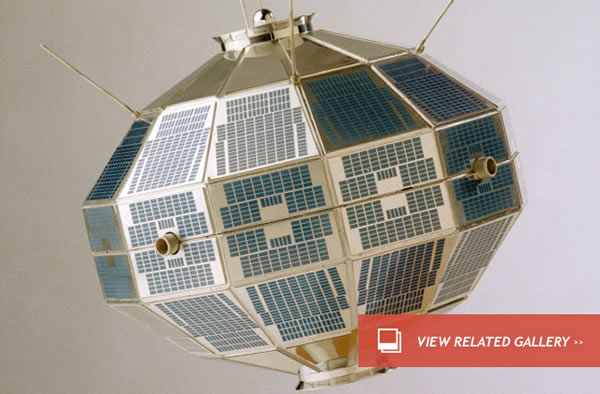Happy Canada in Space Day!
Though Canada may be best known for putting both the space shuttle’s robotic arm and Chris Hadfield into low Earth orbit, the nation actually has a long history in space. This weekend marks the 51st anniversary of Canada becoming a spacefaring nation. Its first satellite, Alouette-I, was launched on Sept. 29, 1962.
Development of Alouette-I began with an invitation from NASA in 1958. The agency, which would go on to recruit 32 Canadian engineers into the Space Task Group the following year, reached out to its northern neighbor seeking international collaboration in its fledgeling satellite program.
Within months, two scientists with Canada’s Defense and Research Telecommunications Establishment (DRTE), John Chapman and Eldin Warren, submitted a proposal to NASA to build a satellite that could monitor the Earth’s ionosphere from orbit.
NASA accepted the proposal. A team of DRTE scientists under Chapman’s leadership set to work designing and building two identical satellites christened Alouette.
Progress was slow; not only was the space age in its infancy, this was the first time Canadian engineers had attempted to build a satellite. The team met a number of engineering setbacks, but the new technologies that emerged at the time like solar cells and transistors enabled the team to finally built a small, reliable spacecraft.
The final satellite, Alouette-I, was finished after three and a half years of construction. It was a conservative design fitted with a modest science payload that included an ionospheric sounder, a VLF receiver, an energetic particle detector, and a cosmic noise experiment.
Two dipole antennas, one measuring nearly 150 feet and the other close to 75 feet, extended from the satellite shell; both were shared by three of the experiments on the spacecraft. It weighed just under 320 pounds.
The flight ready satellite was shipped to California and launched from the Pacific Missile Range on a two-stage Thor-Agena rocket at 2:06 in the morning. It was placed into a near perfect 621-mile orbit. And then it got to work, spin-stabilized at about 1.4 rpm after its antenna had extended.
The design and engineering that had gone into Alouette-I proved to be incredibly sound. The mission was launched with a one-year life span, but its mission was extended into a 10-year mission.
But the extended mission wasn’t without some hiccups. About 500 days after launch, the spin rate slowed to an unexpected 0.6 rpm; scientists suspected the satellite’s gradual progression to a gravity gradient stabilization because its longest antenna was constantly pointing towards the Earth.
But Earth-facing antennae were a necessity on this mission since the spacecraft didn’t have a tape recorder. Scientists could only gather data as telemetry from tracking stations near Hawaii, Singapore, Australia, Europe and Central Africa, which gathered data for about six hours every day.
When operations on Alouette-I were terminated in September of 1972, no one could deny it had been a striking success. Over the course of its active life, Alouette-I gathered more than one million images of the ionosphere, and in the late 1990s a data restoration effort saved a considerable portion of high-resolution data before the telemetry tapes were finally discarded.
The second Alouette spacecraft, Alouette-2, was refurbished and flown in 1965 under a Canadian-American agreement to launch satellites under the International Satellites for Ionospheric Studies (ISIS) program. Two new satellites, ISIS I and ISIS II, launched successfully in 1969 and 1970 respectively.
It was a very good start to Canada’s now 51-year long history in space.
Photo: Launched on September 29, 1962, the Alouette-I scientific satellite marked Canada’s entry into the space age. Credit: Canadian Space Agency(Sep 28, 2013 06:00 PM ET // by Amy Shira Teitel)












